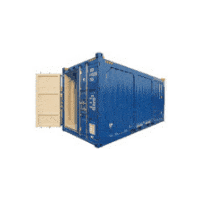
Whether it’s your car or your offshore container that needs service, you should make sure that tje workshop knows the brand.
It is early in the morning and the highway is almost empty. The car feels like it slides perfectly through the curves. It has just been to the workshop just to be checked. The mechanic might not have been authorized by the car brand, but that’s no problem. He has experience with a range of car brands. Your foot gets a little heavier. The car gets just a little more speed. Maybe a little more than needed, but it has to be tested a bit. Suddenly you hear the <klonk> sound that no car owner ever wants to hear. Something is wrong.
You complain to the mechanic who might just blame the car manufacturer. You complain to the authorized car manufacturer’s workshop who may just blame your unauthorized mechanic. While looking at the anonymous mini-car that is made available to you, you are getting less and less concerned with who is responsible, and more interested in just getting your own car out on the road again.
Just like your car mechanic should have, we have serious considerations about who produced the unit before beginning a modification of an offshore container. Whatever has to be done, the offshore container needs to go into service in a safe and efficient manner afterwards, and under no circumstances be left staying in the port.
Are all offshore containers not alike?
Offshore containers are typically regulated within framework of standards such as DNV 2.7-1. Although there are many details found here, as with any regulatory framework there can be room for different ways of interpretation. As long as the container is kept in it’s original entirety, we should expect that the strength is maintained, but for even small changes, who knows what impact it will have on the overall whole?
The containers will typically be certified according to different principles. In some cases, it is designed, approved, manufactured, and tested on the basis of DNV 2.7-1, while in other cases approved under other schemes while ALSO being according to DNV 2.7-1. It is therefore likely that any class company will reserve the right to not accept or recertify a container originally certified by another class company without first reviewing the design and verifying compliance with the standard.
No matter the differences in design principles, our starting point is always that one must respect the DNV 2.7-1 idea that was with the offshore container at it’s birth. The same idea should be pursued when you modify a container. It may not necessarily be read from a piece of paper or certificate, but is best available by asking, for example, on what basis the class surveyor worked or what ideas the engineers at the factory had with the container.
Differences in appearances
The most recent example that we have worked on have has been changing the side of a 20’ offshore container. All available designs were in one way or another according to DNV 2.7-1. Just by taking a look at the containers load bearing parts, it’s easy to see a difference in the construction principles, i.e. the number of profiles, material thickness, etc.. The question is whether it was just differences in design principles or expressed a different distribution of overall strength, or perhaps both? Regardless, we will always choose the safe option and examine it fully instead of taking a shortcut and gambling with a design.
There is no doubt that the best thing would always be to build the container 100% according to your requirements from the start. But we fully respect that it’s not always possible, due to time or other factors. Do you have a project in mind, you are very welcome to have a chat with us about the possibilities and limitations. Go have a look at our stock at Esbjerg Maritime Service at Lillebæltsvej 42 in Esbjerg, where we have a large selection of offshore containers in different sizes, in different designs depending on whether it is the Norwegian sector, Danish sector or elsewhere, and certified by various class companies like DNV-GL , Llloyd’s Register, Bureau Veritas.







